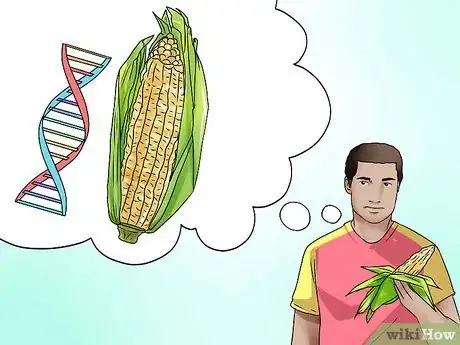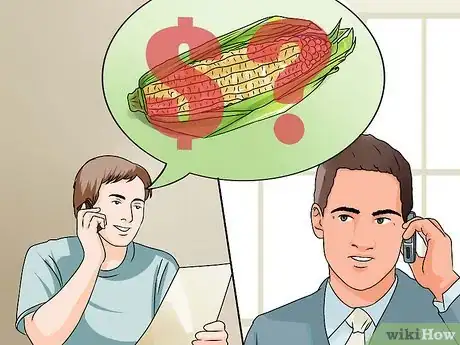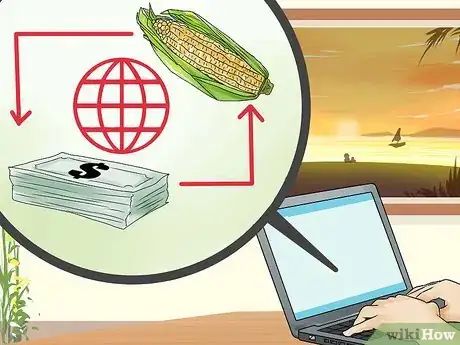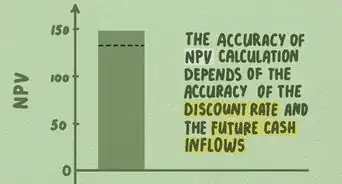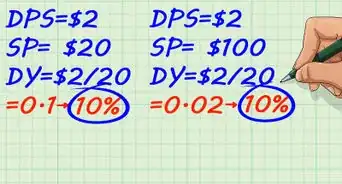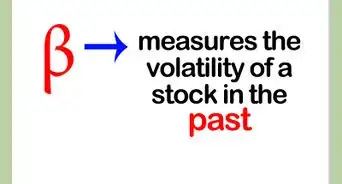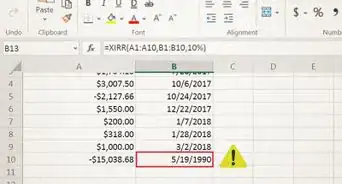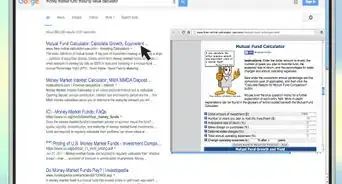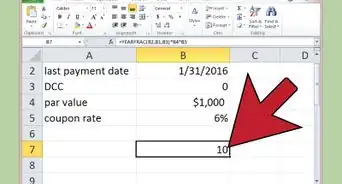wikiHow is a “wiki,” similar to Wikipedia, which means that many of our articles are co-written by multiple authors. To create this article, volunteer authors worked to edit and improve it over time.
There are 11 references cited in this article, which can be found at the bottom of the page.
This article has been viewed 49,155 times.
Learn more...
Buy low, sell high. That’s the golden rule for any financial venture including buying corn commodities. Corn is one of the world’s most widely farmed crops, in part, because corn is needed for foodstuffs, plastics, and biofuel around the world. That makes corn a good investment and a fairly stable one. In order to buy corn commodities, often referred to as futures, and make a profit, you’ll need to take into account how a variety of real world factors might affect prices before you actually go through the purchasing process.
Steps
Tracking Important Market Factors
-
1Understand what factors affect corn production. When trying to predict whether corn will go up or down in price, it is important to know about the agriculture business and what factors lead to a profitable or a lousy harvest.
- Read up on the kinds of corn that are being sewn. In recent years, farmers have started to use genetically modified strains of corn that are resistant to disease, require less water and sunlight, and are even resistant to fire and flood. These hardier strains of corn are more likely to yield abundant crops, which can affect the price of corn on the market.[1] If you discover that a new strain of corn will be used in the coming year, you may choose to buy more, banking on the promise of a better corn yield.
- Consider the effect that new fertilizers, irrigation techniques, or farm equipment might have on production. Will these factors lead to a greater crop yield? Will farmers have to pass the cost of these upgrades off to the consumer? These are questions to consider and to read up on regularly.
- Think about weather too. All crops need water. Drought and floods can equally ruin a corn crop yield. The majority of the corn crop in the world is grown in the United States and China. Pay attention to weather in both areas and agricultural reports about rainfall to determine possible effects on corn commodities.[2]
-
2Anticipate the needs of businesses that use corn. Corn is primarily produced for livestock consumption. Most foods that cats and dogs eat contain “grains” which in many cases include cornmeal. What remains is packaged for human consumption or forms the basis for many industrial goods that use starch, high fructose corn syrup, or ethanol. Follow companies that purchase a lot of corn for their products. Anticipate conditions that might lead to rising prices like increased consumer demand, the opening of new factories, and the expansion to new markets.
- Ethanol production, in particular, depends heavily on corn. Ethanol or ethyl alcohol is used for alcoholic beverages, medical supplies, and fuel. Ethanol is the single largest fuel additive in the world and is produced all over the world. The United States alone produced 13.8 billion gallons of ethanol in 2011 and companies like ADM, Poet, Valero Energy Corporation, Green Plains Renewable Energy, and Flint Hills Resources LP produced 40% of the total amount in the US.[3] Pay attention to the major companies in your country. Spikes in prices often follow decisions to open new ethanol plants, which will require more corn to process.
Advertisement -
3Keep an eye on corn politics. This may sound funny, but government regulations can affect the ways that corn commodities are regulated and priced. For example, if the government places an increased tax on the shipment of corn across state lines, you’ll probably be paying a higher premium for your corn futures. Lowly farmers and big agricultural conglomerates won’t want to foot the bill, so they’ll raise the prices.
- Similarly, if you read that the government will pass legislation making it easier to make, move, and sell corn, you can anticipate cheaper prices. Follow www.ethanolproducer.com for insider knowledge into the workings of corn politics and the ethanol industry.
-
4Pay attention to projection analyses. These come from the government.[4] Watch television. Read newspapers. See what “leading experts” say about government reports on commodities like corn.[5] Remember too that everyone else in the business is watching with an eager eye as well. Use this information to best assess when you should buy and sell, but don’t get too hotheaded. Many media conglomerates drool over dramatic conjecture. If they manage to create a stir, they'll see better ratings. This could lead them to exaggerate certain things.
- If the news analyst tells you to sell for whatever reason, double and triple check their stances with other information outlets. See what others are saying about the same topic. It is possible that you could actually gain from this process. If others, less even-tempered than yourself, sell off at cheaper prices, you might even pick up more futures in the long run for less money.
-
5Remember the “hurricane factor”. Certain commodities like lumber, natural gas and corn are in higher demand during hurricane season. Track the season and the predictions, and buy corn commodities in plenty of time to anticipate hurricane season demand. In the case of corn, other weather conditions (including drought and hail as well as widespread good weather) can drive supply up or down and affect future prices.[6]
Buying Corn Commodities
-
1Find a commodity broker. You can look locally or online. Either way, your commodity broker should have experience selling on the corn market. They’ll be able to offer advice based on recent trends in corn futures.[7]
- Look in trading magazines or the phone book to find a local broker. Many periodicals like Futures Magazine, Stocks and Commodities Magazine and Stocks, Futures and Options Magazine will contain advertisements for various firms around the country and the world.
- Look online. Websites like commoditybrokersonline.com lists over 700 online reputable brokers and provides their contact information.
- Make sure he is not a “high pressure” broker. You want someone who won’t push you beyond your comfort zone. Many brokers push your finances to the brink to ensure that they’ll take home higher commissions. Remember, in the end, it is your money, so you are assuming most, if not all, of the risk. Look for a broker who will give advice, but not push too hard.[8]
-
2Open an online trading account. This is a simple step. Most commodity brokerage firms provide some online account services. Fill out the form online or on the premises. Most online trading accounts are free to start and free to use. If you are asked to pay a fee prior to use, consider another brokerage firm.
-
3Purchase commodities through your online broker. The way you purchase commodities is through futures contracts. Futures contracts are agreements between buyers and sellers. They list a price at which the commodity has been purchased and a date by which the goods must be delivered. You will either sell or transfer futures so that you’ll never actually receive these goods. You are purchasing a contract, not the actual goods.
- Big companies buy and sell futures on a regular basis. For example, if corn is at a cheap premium early in the year, a company like Kellogg will pay the going market price for the commodity to be delivered months later. If it turns out that the price of corn futures goes down weeks later, then Kellogg made a poor decision. If the price goes up, then they saved a lot of money by buying corn commodities ahead of time at a cheaper price.
-
4Decide whether to buy corn commodities on margin. Margin refers to a loan that your broker provides you so you can have more buying power in the market. As you can imagine, this can dramatically increase profits, but can also place you at a greater risk of losing money.
- For example, if you wanted to buy $100 in corn commodities, you could purchase it on margin and decide how much the broker would lend you for the purchase. If the broker matched your $100, you would have bought $200 in corn commodities. If the market price of corn rose by 25%, then your futures would be worth $250. If you decide to sell at that point, you’d take your $250 and pay your broker $100 plus a small interest rate. You would have made close to $50 on your investment. If you did not buy on margin, you’d only have made 25% of $100 ($25). Similarly, if the price plummets and is only worth $100 and you decided to sell, you’d have to still pay back the broker their original $100 plus a small interest rate, leaving you in the negative. If you hadn’t bought the corn commodity on margins in this scenario, you’d have just lost your money.[9]
-
5Buy commodities through ETFs. Purchase commodities by buying shares of ETFs (exchange-traded funds). ETFs are funds that follow indices, such as the S&P 500.
- This is an easier way to trade in commodities. You don’t have to spend a lot of time researching commodities or deciding which ones to buy. Instead, the investment management team that manages the fund will do this work.
- ETFs are good too if you want to buy other commodities besides corn. This is called diversification. If for some reason the entire USA corn yield succumbs to bacteria or is damaged by severe storms, you’ll lose your commodity investment because there will be no crop yield to sell when it actually makes it to the market. If you diversify, one rampant corn plague or freak disaster won’t ruin your portfolio. [10]
-
6Get commodities through mutual funds. Many investment management groups also manage mutual funds in addition to ETFs. Mutual funds will not only consist of commodities, but other securities, such as bonds or stocks.
- Mutual funds help to diversify your portfolio like ETFs. In general, ETFs are more popular than mutual funds. They are taxed less frequently and trade like stocks. Mutual funds buy and sell at the end of a day when market prices are set.[11]
Community Q&A
-
QuestionWhat have the May and June Corn Market Prices been the past 10 years?
 DonaganTop AnswererGo to Macrotrends.net/2532/corn-prices-historical-chart-data.
DonaganTop AnswererGo to Macrotrends.net/2532/corn-prices-historical-chart-data.
References
- ↑ http://www2.ca.uky.edu/entomology/entfacts/ef130.asp
- ↑ http://www.bloomberg.com/news/articles/2014-07-21/corn-slumps-to-four-year-low-as-global-supplies-seen-increasing
- ↑ http://farmindustrynews.com/ethanol/5-largest-ethanol-producers
- ↑ http://www.usda.gov/oce/commodity/wasde/
- ↑ http://www.agweb.com/crops/corn/
- ↑ http://thismatter.com/money/commodities/commodities.htm
- ↑ http://commodities.about.com/od/findingabroker/a/broker-search.htm
- ↑ http://commodities.about.com/od/findingabroker/a/commodity-sales.htm
- ↑ http://www.investopedia.com/terms/m/margin.asp
